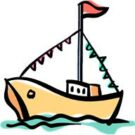Canal Boats Used to Haul Cargo in 1800s

Did you know …
Canal boats weren’t just used by passengers. Freight boats were another important part of traveling on the canal.
The mules on the towpath hauled large loads. The cargo could weigh from fifty to eighty tons. The boats carried salt pork, lard, coal, flour, lumber, coffee, tea, chocolate, wheat, corn, cheese, wool, cloth, sugar, and molasses.
A team of horses couldn’t pull fifty tons over land in a wagon. The water helped to carry the load.
Think of the big trucks on the highways today. They haul large loads over great distances. Freight boats did this job over one hundred fifty years ago.
The captain’s family and crew lived on the freight boats, which were about seventy to eighty feet long and fourteen feet wide.
During the winter months in the colder climates, the boats stopped running while the canals iced over. This gave the captain’s children a chance to attend school.
Many industries built the businesses along the canals, such as grist mills (where grain is ground into flour,) boatyards, stables, paper mills, and general stores.
There were even some businesses that traveled on canal boats. These included barber shops, stores, print shops, sign-makers, actors, singers, and dancers.
Those days are long gone now, but there are a few places where you can still ride on a mule-drawn canal boat. One of them is located in Roscoe Village, Ohio.
– Sandra Merville Hart
Resource
Gieck, Jack. A Photo Album of Ohio’s Canal Era, 1825-1913, The Kent State University Press, 1988.




